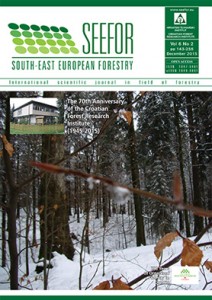 A paper on genetic variability in Austrian pine trees apparently didn’t vary enough from other work.
A paper on genetic variability in Austrian pine trees apparently didn’t vary enough from other work.
The journal is now retracting the 2012 paper for having significant overlap with another paper published in 2008. Another researcher pointed out the duplication — which was unintentional, according to the note, the result of
an apparent failure in communication between the co-authors on both papers which caused the papers to be overlapped.
The overlapping papers share a first author, Aleksandar Lucic, who works at the Institute of Forestry in Serbia. The other author on both papers is Vasilije Isajev, at the Faculty of Forestry in Belgrade.
“Analysis of Genetic Variability of Austrian Pine (Pinus nigra Arnold) in Serbia Using Protein Markers” was published in South-East European Forestry. The journal is not indexed on Thomson Scientific’s Web of Knowledge.
Here’s the retraction note:
The following paper from South-east European forestry, ‘Analysis of Genetic Variability of Austrian Pine (Pinus nigra Arnold) in Serbia Using Protein Markers by Aleksandar Lučić, Vasilije Isajev, Ljubinko Rakonjac , Vladan Popović, Radovan Nevenić, Tatjana Ćirković-Mitrović, Ljiljana Brašanac-Bosanac, published in Volume 3 No 1 (June 2012), has been retracted by agreement between the authors and the journal Editors. The paper has been retracted due to significant overlapping with the following paper ‘Genetic characterisation of genotypes of Austrian pine (Pinus nigraArnold) populations using protein markers’ by Aleksandar Lučić, Ana Nikolić, Snežana Mladenović Drinić, Vasilije Isajev, Vera Lavadinović published in Genetika, Volume 40, No 2, pages 157-168, DOI:http://dx.doi.org/10.2298/GENSR0802157L (2008).
Authors pointed out that there was no intent for ‘self-plagiarism’, but that there was an apparent failure in communication between the co-authors on both papers which caused the papers to be overlapped.
Editors of South-east European forestry and authors of the retracted paper apologize to the readers of the journal for not detecting this omission during the publishing process. We thank Dr Paulo Baptista for bringing this to our attention.
On PubPeer, a commenter points out overlap between the methods, discussion, and results.
Lucic filled us in on the backstory:
The comment obtained from Paulo Baptista was a big surprise for the co-authors themselves, after which the co-authors checked both papers, had consultation among themselves and found that unintentional self-plagiarism has occurred. The letter to Seefor editors with a request for retraction of the paper was immediately sent. The reason for this omission was a miscommunication between co-authors. The first paper was written by one group of participants in the research in the year 2008, and the second paper was written by other group of participants in the research in 2012-2013. Unfortunately, co-authors who wrote the second paper did not have the information that the paper with the same object of research has already been published.
He also told us what he plans to do to prevent a similar situation from happening again:
All the above mentioned incited the co-authors and participants in the research to establish better coordination in the future in order to avoid similar omissions.
Lucic is a co-author on another paper published in 2014 in the journal Genetika that a commenter on PubPeer suggested may contain some overlap with a 2013 paper in Archives of Biological Sciences (which had to clean house with 16 retractions following a recent investigation). The commenter also requested to see the raw data.
Lucic confirmed to us that the authors posted a rebuttal to these allegations on the PubPeer entry for the 2013 paper, in which they declined to provide raw data:
We are not unable to provide you raw data of measurements even though they certainly exist. They were available to paper reviewers.
We’ve reached out to Genetika to see if they’ve looked into the paper discussed on PubPeer. We will update this post with anything else we learn.
Like Retraction Watch? Consider making a tax-deductible contribution to support our growth. You can also follow us on Twitter, like us on Facebook, add us to your RSS reader, and sign up on our homepage for an email every time there’s a new post. Click here to review our Comments Policy.